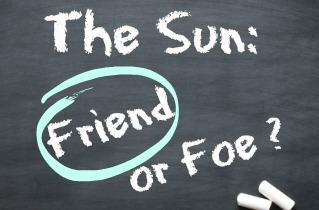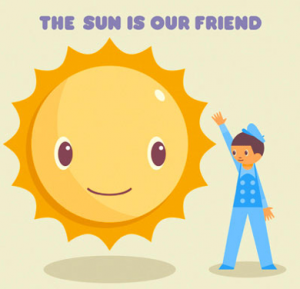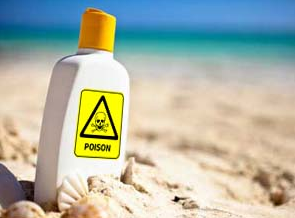
The Argument for Giving Sunscreen a Break
 Are you one of those people who always thinks that summer is too short?
Are you one of those people who always thinks that summer is too short?
Like it or not, summer must end. Don’t fret: outdoor fun is possible all year round. Fall is the time of leaf piles, camping, hiking, football and kickball.
Even as the temperature drops, it’s easy to overextend your sun exposure. But we’ll walk you through how to protect yourself – from the sun and dangerous chemicals, too.
The Sun Isn’t Deadly
Natural sunlight’s potential to harm you has really been blown out of proportion in more recent years.
The sun is healthy for you! It’s all about SAFE sun exposure (not tanning nonsense).
 Back in the day, both my mom and dad were lifeguards in their teens and never used sunscreen. No one did, really. Yet not one of my parents or their lifeguarding friends ever developed skin cancer, premature aging, wrinkles, OR other sun related ailment more serious than a simple sunburn.
Back in the day, both my mom and dad were lifeguards in their teens and never used sunscreen. No one did, really. Yet not one of my parents or their lifeguarding friends ever developed skin cancer, premature aging, wrinkles, OR other sun related ailment more serious than a simple sunburn.
BUT, thanks to many doctors, health officials, advertisements, beauty experts, corporations, and well-meaning friends, YOU have been told that you need to stay out of the sun.
Little scientific evidence justifies the many health campaigns that urge you to completely avoid the sun: overdosing on sunscreen just doesn’t make sense. Study after study shows the benefits of a little rays.
Give the Sunscreen a Break
Many sunscreen brands are still made with ingredients that are potentially harmful to you and the environment.
Here’s what you should NEVER use for protecting against the sun:
- Spray Sunscreen – these super-popular aerosolized sunscreens may seem like a dream come true but they may pose serious health and environment risks. While they no longer contain chlorofluorocarbons (also known as CFCs, which were phased out in the 1990s for causing holes in the stratospheric ozone layer), but contain chemicals that penetrate the skin and may disrupt the body’s endocrine system.
- PABA – this ingredient is rarely used today. It can cause a host of reactions and
 may even increase the risk of skin cancer in certain individuals.
may even increase the risk of skin cancer in certain individuals. - Super High SPFs – sunscreens with high Sun Protection Factor (like 75 or 100) may protect against UVB radiation that cause sunburns but could leave your skin exposed to damaging UVA rays, which penetrate deep into the skin, suppress the immune system, accelerate skin aging and may cause skin cancer. High SPF also doesn’t mean you have to apply less, you still have to apply sunscreen about every 2 hours regardless of SPF value.
- Oxybenzone – these chemicals can penetrate the skin, get into the bloodstream and act like estrogen. This can trigger allergic reactions and/or disrupt the development of reproductive organs. More than 40 percent of all beach and sport sunscreens in this year’s guide contain oxybenzone.
- Suncreen Towelettes/Powder – the FDA prohibits sunscreen wipes and powders because of dubious sun protection AND inhalation of loose powders can cause lung irritation or other harm.
- Combined Sunscreens/Bug Repellants – Bugs aren’t typically a problem during the peak hours of UV exposure AND bug spray doesn’t need to be reapplied as frequently as sunscreen, rendering these pointless. Plus, they cannot be applied to the face. According to the EWG, studies suggest that combined sunscreen repellents lead to increased skin absorption of the repellent ingredients.
Looking for a sustainable and chemical-free solution to sunscreen? The Environmental Working Group releases an annual guide to the best sunscreens.
Clothing Can Protect You
The best way to avoid unwanted sun exposure is to cover up!
 A skirt can protect your legs but still allow you to not become overheated. Shirts protect skin that usually doesn’t see the light of day and more likely to burn. Hats and caps shade the eyes, allowing you to benefit from the sunshine while keeping the sun off the sensitive, thin skin around your eyes.
A skirt can protect your legs but still allow you to not become overheated. Shirts protect skin that usually doesn’t see the light of day and more likely to burn. Hats and caps shade the eyes, allowing you to benefit from the sunshine while keeping the sun off the sensitive, thin skin around your eyes.
Limiting sun exposure, wearing protective clothing, and using a natural, non-chemical sunscreen can reduce the risks of the harmful effects of the sun.
Readers, don’t be afraid of the sun, embrace it!









